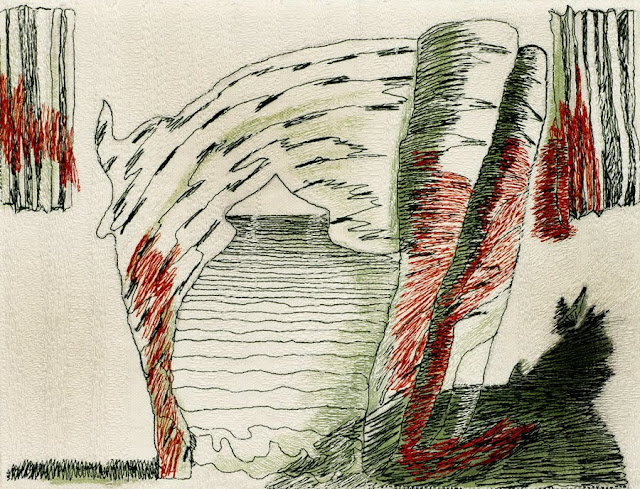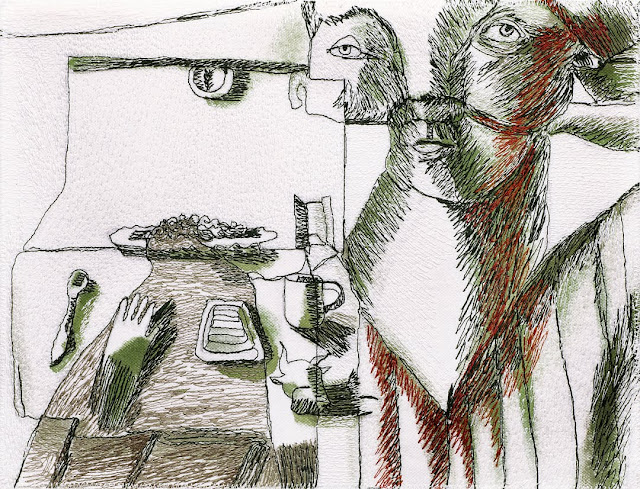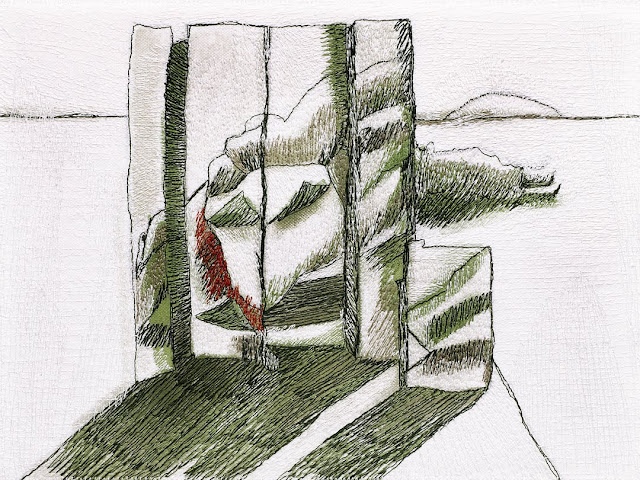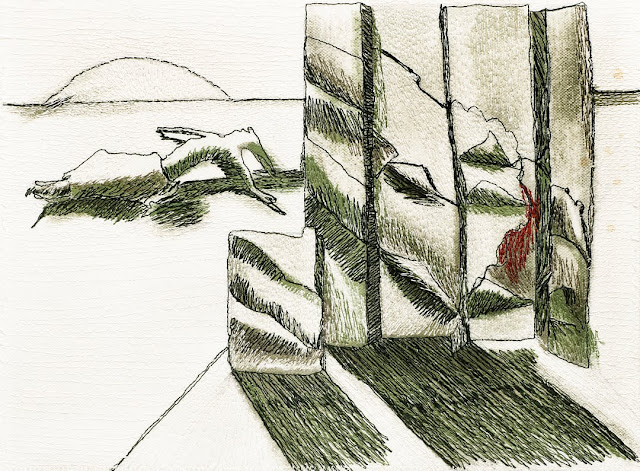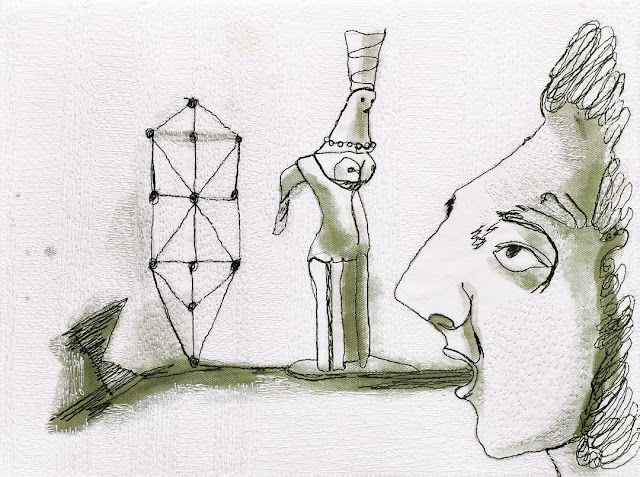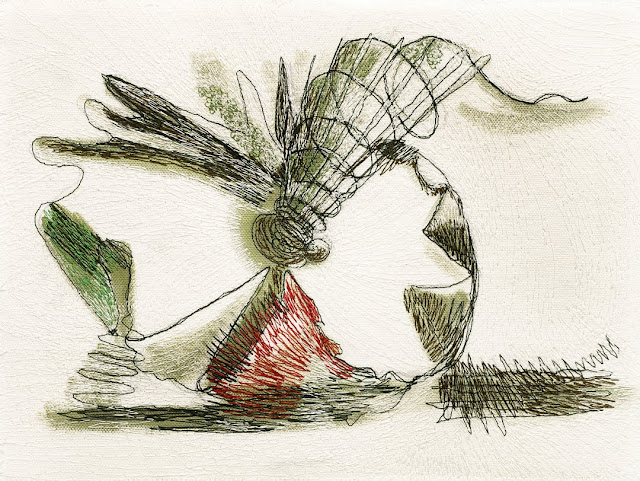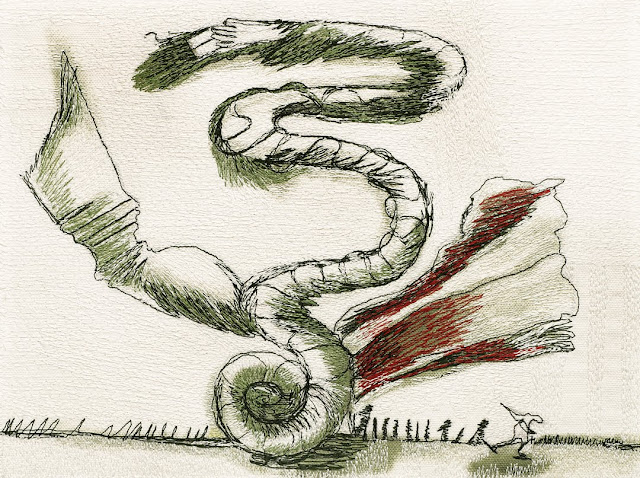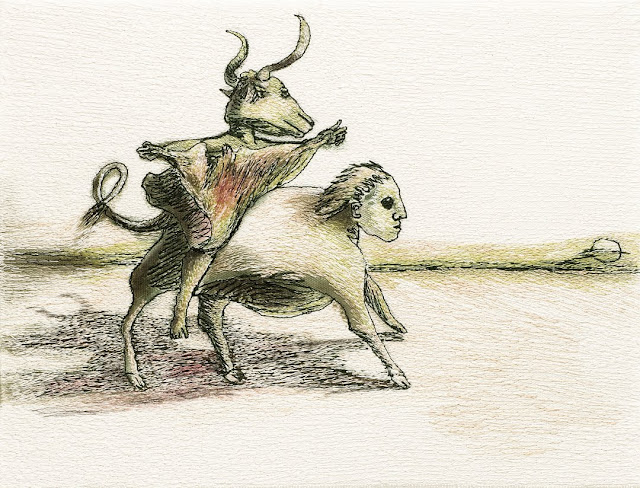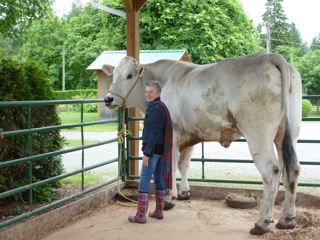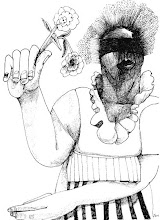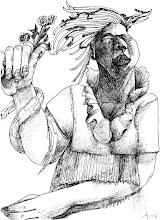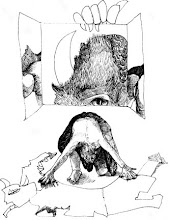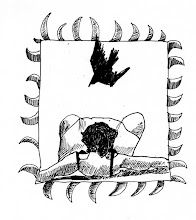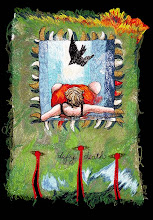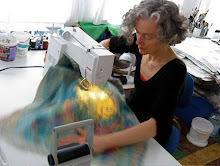The work for 1001 Funny Things began as research on the history and mythology of the skirt.
Writer Elizabeth Dancoes has done brief, original stories based on our research but in contemporary idiom.
In total we have worked together on approximately 10 stories, three of these are forming the basis for this exhibit. They are Lunch, She Who Walks and Knowing.
The images and stories are based on the ancient, mysterious gesture known as “Ana Suromai”, literally “to raise the skirt”. The origins of this intriguing gesture come to light in the Demeter, Persephone story from Ancient Greece. The gesture haunts so much of subsequent mythology and story that it can hardly be ignored.
Ana Suromai (“to raise the skirt”) was an incitement to transformation. And while its spiritual implications were deep, it encouraged laughter as a conduit to renewal. It resonates in fables in the guise of mysterious things concealed beneath a woman’s skirt and continues into modern times with the ever-present and compelling image of Marilyn Monroe’s skirts billowing over a subway grate. As anyone who as ever work a skirt will tell you it is a spontaneous gesture.
My work for the series includes drawings, paintings and embroideries as well as digital images that are made to resemble embroidery and traditional stitchery.
For me this work reflects my intense emotional, expressive involvement in cloth, in sewing and stitching cloth, in interpreting cloth in paint and in pure, unadulterated, long hand stitching, the stitch as a teller of tales taking in and speaking with each breath, with each passing of thread through cloth.
Though the images reflect the humour and magic of Elizabeth’s stories, it was the sharing of our respective experiencing of the gesture of “Ana Suromai” that inevitably inspired the revelations that inform the visual notions that run through both text and image. We initially worked simultaneously on the evolution of one set of image and story then she wrote for my drawings, as we evolved Elizabeth wrote and I interpreted. Part of our desire for this exhibit it to share the methods and means of this ongoing, productive collaboration.
Monday, June 17, 2013
Sunday, December 11, 2011
Eleanor Hannan - KNOWING
The Craft Council of BC’s gallery is a very small space, but Eleanor Hannan’s exhibition “Knowing” fills it to overflowing with image, metaphor and myth. This is not to say the work clutters the space, on the contrary, the embroidered works –no larger than a sheet of paper– travel around the walls in a shimmering line. Hannan has more than illustrated Elizabeth Dancoe’s short and witty story, she has built on it; the images are evocative and often cryptic. To describe the story even more briefly: a woman lives in a state of discontent; she is restless, searching. During a quiet moment, she perceives a fork in the road, so to speak. She follows it and the adventure transforms her.
Hannan works with a restricted palette of white, black, soft green, salty red threads and faint washes of paint. She literally draws with the sewing machine, outlining a fingernail or the pattern in the foam on a cappuccino. Her stitches swarm together to describe the density of shadows. The result is expressive, active, confident. The small images convey space, weight and ambiguous emotions that crowd together in as many layers as the stitches. At the outset, the central character seems utterly fatigued –she almost disappears in the gloom of the “unpopular cafe”; but then she dances gleefully at the foot of a strange, electric tornado or spreads her arms like a flying superhero. Not easy things to conjure with a single filament.
Central to the project is the performative act of raising the skirt –Ana Suromai in ancient Greek. The story nods to the myth of Demeter. While searching for her daughter she is given shelter in a home. Baubo, a female servant, is touched by Demeter’s sorrow and flips up her skirt to make the great goddess laugh. This gesture is also said to “cow bulls.” At first I imagined a rather hard-line feminist ending to the little tale, yet as the character progresses and develops, I am surprised. Indeed, she raises her skirt to a bull. The poor creature is bowled over, hooves in the air and, when he finally rights himself, she climbs on his back, her skirt skimming her thighs. In the next image, the bull’s head is on the figure wearing the skirt and the woman’s head is on the galloping beast. In it, I read that the act of exposing oneself (not in the sense of the pervert in the park) and becoming vulnerable leads to mutual understanding and momentum.
The exhibit includes a wealth of support material presented in an unobtrusive manner. Dancoes reads the story, sotto voce, in a recording. A small digital photo frame features text and images that present information on the extensive research done by both Hannan and Dancoes into the mythology and spiritualism permeating the work. A fat little book features “sketches” –hand embroidery in black thread on canvas squares where Hannan has explored imagery and text. Considering the time invested in each cloth page, the images certainly have the immediate, experimental feel of drawings.
The final sentence of the story spins off the wall in a slightly larger piece that sports a strange maroon shape. In reading the support material, I learn that the shape is the hoof-print from a real bull. It is not clear whether Hannan had to lift her skirts to tame him, but in the photo, he seems calm and obliging. Hand embroidered imagery and text circles the hoofprint; a woman’s figure in a red skirt strides into the distance. She has inventiveness, courage, and maturity as the letters swirl around her: “I don’t know, I’d be content with a small herd, maybe 18, a few colourful skirts and a red petticoat.”
The works are, of course, best seen ‘live’, but one can also visit:
www.1001funnythingswithaskirt.blogspot.com/
The Craft Council of BC’s gallery is a very small space, but Eleanor Hannan’s exhibition “Knowing” fills it to overflowing with image, metaphor and myth. This is not to say the work clutters the space, on the contrary, the embroidered works –no larger than a sheet of paper– travel around the walls in a shimmering line. Hannan has more than illustrated Elizabeth Dancoe’s short and witty story, she has built on it; the images are evocative and often cryptic. To describe the story even more briefly: a woman lives in a state of discontent; she is restless, searching. During a quiet moment, she perceives a fork in the road, so to speak. She follows it and the adventure transforms her.
Hannan works with a restricted palette of white, black, soft green, salty red threads and faint washes of paint. She literally draws with the sewing machine, outlining a fingernail or the pattern in the foam on a cappuccino. Her stitches swarm together to describe the density of shadows. The result is expressive, active, confident. The small images convey space, weight and ambiguous emotions that crowd together in as many layers as the stitches. At the outset, the central character seems utterly fatigued –she almost disappears in the gloom of the “unpopular cafe”; but then she dances gleefully at the foot of a strange, electric tornado or spreads her arms like a flying superhero. Not easy things to conjure with a single filament.
Central to the project is the performative act of raising the skirt –Ana Suromai in ancient Greek. The story nods to the myth of Demeter. While searching for her daughter she is given shelter in a home. Baubo, a female servant, is touched by Demeter’s sorrow and flips up her skirt to make the great goddess laugh. This gesture is also said to “cow bulls.” At first I imagined a rather hard-line feminist ending to the little tale, yet as the character progresses and develops, I am surprised. Indeed, she raises her skirt to a bull. The poor creature is bowled over, hooves in the air and, when he finally rights himself, she climbs on his back, her skirt skimming her thighs. In the next image, the bull’s head is on the figure wearing the skirt and the woman’s head is on the galloping beast. In it, I read that the act of exposing oneself (not in the sense of the pervert in the park) and becoming vulnerable leads to mutual understanding and momentum.
The exhibit includes a wealth of support material presented in an unobtrusive manner. Dancoes reads the story, sotto voce, in a recording. A small digital photo frame features text and images that present information on the extensive research done by both Hannan and Dancoes into the mythology and spiritualism permeating the work. A fat little book features “sketches” –hand embroidery in black thread on canvas squares where Hannan has explored imagery and text. Considering the time invested in each cloth page, the images certainly have the immediate, experimental feel of drawings.
The final sentence of the story spins off the wall in a slightly larger piece that sports a strange maroon shape. In reading the support material, I learn that the shape is the hoof-print from a real bull. It is not clear whether Hannan had to lift her skirts to tame him, but in the photo, he seems calm and obliging. Hand embroidered imagery and text circles the hoofprint; a woman’s figure in a red skirt strides into the distance. She has inventiveness, courage, and maturity as the letters swirl around her: “I don’t know, I’d be content with a small herd, maybe 18, a few colourful skirts and a red petticoat.”
The works are, of course, best seen ‘live’, but one can also visit:
www.1001funnythingswithaskirt.blogspot.com/
Sunday, July 24, 2011
Knowing
KNOWING
The story
I always knew that one day I would find myself somewhere else. My therapist assured me it was a resistance to commitment but I continued to save for that eagerly awaited moment, content to deny myself luxuries she implied were an insane depravation. Well, that day finally arrived when, on my fortieth birthday against all odds in an unpopular cafe on Main, an abandoned brochure attracted my attention over cappuccino: KINESTHETICS, KUNDALINI AND THE KABALA ON KNOSSOS FOR UNDER $300 A DAY and I had my very first vin-dit (a very personal shove in the direction of my zah-mah-ki-bo, remember Bokonon?).
The process must remain secret (though the weather’s been great) but these three things may be revealed: rather than uncoiling spiritual energy up the spinal channel to the radiant thousand petaled lotus, as per usual, I have been directed to master unfurling the curled kundalini OUT; I have rediscovered horns, crescent moons, sacred Yonies and the mystic in mathematics: 25,920 (2+5+9+2+0=18, 1+8=9, 9 3=3) makes my heart beat faster (43200 beats in twelve hours and 25920 60=432, 432,000: the number of years reckoned to the Kali Yuga, wow!); and this morning in the pale absinthe dawn of the new moon, I lifted my skirts and cowed the bull, my bare feet wound themselves in the curls at his loins and I rode him, the power in his shanks shifting between my thighs - well, let’s just say life hasn’t been the same since. And thanks to high interest no risk futures I can pursue my dream; I don’t know, I’d be content with a small herd, maybe 18, a few colourful skirts and a red petticoat.
The story
I always knew that one day I would find myself somewhere else. My therapist assured me it was a resistance to commitment but I continued to save for that eagerly awaited moment, content to deny myself luxuries she implied were an insane depravation. Well, that day finally arrived when, on my fortieth birthday against all odds in an unpopular cafe on Main, an abandoned brochure attracted my attention over cappuccino: KINESTHETICS, KUNDALINI AND THE KABALA ON KNOSSOS FOR UNDER $300 A DAY and I had my very first vin-dit (a very personal shove in the direction of my zah-mah-ki-bo, remember Bokonon?).
The process must remain secret (though the weather’s been great) but these three things may be revealed: rather than uncoiling spiritual energy up the spinal channel to the radiant thousand petaled lotus, as per usual, I have been directed to master unfurling the curled kundalini OUT; I have rediscovered horns, crescent moons, sacred Yonies and the mystic in mathematics: 25,920 (2+5+9+2+0=18, 1+8=9, 9 3=3) makes my heart beat faster (43200 beats in twelve hours and 25920 60=432, 432,000: the number of years reckoned to the Kali Yuga, wow!); and this morning in the pale absinthe dawn of the new moon, I lifted my skirts and cowed the bull, my bare feet wound themselves in the curls at his loins and I rode him, the power in his shanks shifting between my thighs - well, let’s just say life hasn’t been the same since. And thanks to high interest no risk futures I can pursue my dream; I don’t know, I’d be content with a small herd, maybe 18, a few colourful skirts and a red petticoat.
Thursday, May 12, 2011
Persephone
Tuesday, March 22, 2011
about Still Waves, Defy Death (and the other figures with skirts raised facing into the page)
A friend recently asked me " How can raising your skirts still waves". Such a good question, the basic idea is that raising the skirts exposes the source of all life.
It is a symbolic gesture of course with ancient origins, but the essence of this whole story is the power in that recognition; the gesture exposes the source of all life. Now what is that about? Does that heal? is it simply an expression of creative power? is it useful in this world or does it merely confuse?
I wanted to include here a quote from one of our main sources " The Metamorphosis of Baubo" by Winifred Milius Lubell.
" I think it would be a sad mistake for us to lose sight of Baubo and her icon, the vulva, to relinquish her playful joking, to let her slide out of Western consciousness into scholarly obscurity or into the netherworld of demons and pornography. Her strangeness to modern eyes warns of the danger of her loss. But Baubo is a survivor. She has constantly refused to stay put in a single or confining role of womanhood. She is irreverent she is sacred. She represents those revered sexual and procreative feminine energies that merge to form the nurturers, the transformers and the balancers without whom civilization cannot survive. Baubo's arresting gesture of exposure holds the clue to understanding all the metamophoses of this complex and enigmantic figure."
It is a symbolic gesture of course with ancient origins, but the essence of this whole story is the power in that recognition; the gesture exposes the source of all life. Now what is that about? Does that heal? is it simply an expression of creative power? is it useful in this world or does it merely confuse?
I wanted to include here a quote from one of our main sources " The Metamorphosis of Baubo" by Winifred Milius Lubell.
" I think it would be a sad mistake for us to lose sight of Baubo and her icon, the vulva, to relinquish her playful joking, to let her slide out of Western consciousness into scholarly obscurity or into the netherworld of demons and pornography. Her strangeness to modern eyes warns of the danger of her loss. But Baubo is a survivor. She has constantly refused to stay put in a single or confining role of womanhood. She is irreverent she is sacred. She represents those revered sexual and procreative feminine energies that merge to form the nurturers, the transformers and the balancers without whom civilization cannot survive. Baubo's arresting gesture of exposure holds the clue to understanding all the metamophoses of this complex and enigmantic figure."
Sunday, March 13, 2011
Art Statement for show
The work for 1001 Funny Things began as research on the history and mythology of the skirt.
Writer Elizabeth Dancoes has done brief, original stories based on our research but in contemporary idiom.
In total we have worked together on approximately 10 stories, three of these are forming the basis for this exhibit. They are Lunch, She Who Walks and Knowing.
The images and stories are based on the ancient, mysterious gesture known as “Ana Suromai”, literally “to raise the skirt”. The origins of this intriguing gesture come to light in the Demeter, Persephone story from Ancient Greece. The gesture haunts so much of subsequent mythology and story that it can hardly be ignored.
Ana Suromai (“to raise the skirt”) was an incitement to transformation. And while its spiritual implications were deep, it encouraged laughter as a conduit to renewal. It resonates in fables in the guise of mysterious things concealed beneath a woman’s skirt and continues into modern times with the ever-present and compelling image of Marilyn Monroe’s skirts billowing over a subway grate. As anyone who as ever work a skirt will tell you it is a spontaneous gesture.
My work for the series includes drawings, paintings and embroideries as well as digital images that are made to resemble embroidery and traditional stitchery.
For me this work reflects my intense emotional, expressive involvement in cloth, in sewing and stitching cloth, in interpreting cloth in paint and in pure, unadulterated, long hand stitching, the stitch as a teller of tales taking in and speaking with each breath, with each passing of thread through cloth.
Though the images reflect the humour and magic of Elizabeth’s stories, it was the sharing of our respective experiencing of the gesture of “Ana Suromai” that inevitably inspired the revelations that inform the visual notions that run through both text and image. We initially worked simultaneously on the evolution of one set of image and story then she wrote for my drawings, as we evolved Elizabeth wrote and I interpreted. Part of our desire for this exhibit it to share the methods and means of this ongoing, productive collaboration.
Writer Elizabeth Dancoes has done brief, original stories based on our research but in contemporary idiom.
In total we have worked together on approximately 10 stories, three of these are forming the basis for this exhibit. They are Lunch, She Who Walks and Knowing.
The images and stories are based on the ancient, mysterious gesture known as “Ana Suromai”, literally “to raise the skirt”. The origins of this intriguing gesture come to light in the Demeter, Persephone story from Ancient Greece. The gesture haunts so much of subsequent mythology and story that it can hardly be ignored.
Ana Suromai (“to raise the skirt”) was an incitement to transformation. And while its spiritual implications were deep, it encouraged laughter as a conduit to renewal. It resonates in fables in the guise of mysterious things concealed beneath a woman’s skirt and continues into modern times with the ever-present and compelling image of Marilyn Monroe’s skirts billowing over a subway grate. As anyone who as ever work a skirt will tell you it is a spontaneous gesture.
My work for the series includes drawings, paintings and embroideries as well as digital images that are made to resemble embroidery and traditional stitchery.
For me this work reflects my intense emotional, expressive involvement in cloth, in sewing and stitching cloth, in interpreting cloth in paint and in pure, unadulterated, long hand stitching, the stitch as a teller of tales taking in and speaking with each breath, with each passing of thread through cloth.
Though the images reflect the humour and magic of Elizabeth’s stories, it was the sharing of our respective experiencing of the gesture of “Ana Suromai” that inevitably inspired the revelations that inform the visual notions that run through both text and image. We initially worked simultaneously on the evolution of one set of image and story then she wrote for my drawings, as we evolved Elizabeth wrote and I interpreted. Part of our desire for this exhibit it to share the methods and means of this ongoing, productive collaboration.
Tuesday, March 8, 2011
A few things you should know
A few things you should know before the show:
A long time ago Persephone, the daughter of Zeus and Demeter, was abducted by Hades while out picking Myrtle. Demeter , beside herself with grief, went searching for her. Demeter was goddess of the earth and when the earth goddess grieves things get serious; no water, no crops, no food, no wine....
Demeter wandered searching and she came to the home of the King and Queen of Eleusis where it was her intention to rest (in disguise).
Baubo, a servant in the household, felt deep compassion for Demeter and after having given her as a special drink made from barley danced for her wildly, raising her skirt, in a wild gesture where she raised her skirt, it was said that the gesture made Demeter laugh (uproariously) bringing her out of her grief and giving her hope. The gesture is called “Ana Suromai”- to raise the skirts- the gesture is the basis for these stories.
Note: the “1001 funny things” refers to the “too numerous to count” incidents, stories and myths throughout story telling history that have as there source and meaning this powerful gesture. Elizabeth and I (early on in our work on these stories) discovered the four on which this exhibit is based : Cow Bulls, Still Waves, Blind the Devil, Defy Death.
A long time ago Persephone, the daughter of Zeus and Demeter, was abducted by Hades while out picking Myrtle. Demeter , beside herself with grief, went searching for her. Demeter was goddess of the earth and when the earth goddess grieves things get serious; no water, no crops, no food, no wine....
Demeter wandered searching and she came to the home of the King and Queen of Eleusis where it was her intention to rest (in disguise).
Baubo, a servant in the household, felt deep compassion for Demeter and after having given her as a special drink made from barley danced for her wildly, raising her skirt, in a wild gesture where she raised her skirt, it was said that the gesture made Demeter laugh (uproariously) bringing her out of her grief and giving her hope. The gesture is called “Ana Suromai”- to raise the skirts- the gesture is the basis for these stories.
Note: the “1001 funny things” refers to the “too numerous to count” incidents, stories and myths throughout story telling history that have as there source and meaning this powerful gesture. Elizabeth and I (early on in our work on these stories) discovered the four on which this exhibit is based : Cow Bulls, Still Waves, Blind the Devil, Defy Death.
Subscribe to:
Comments (Atom)

